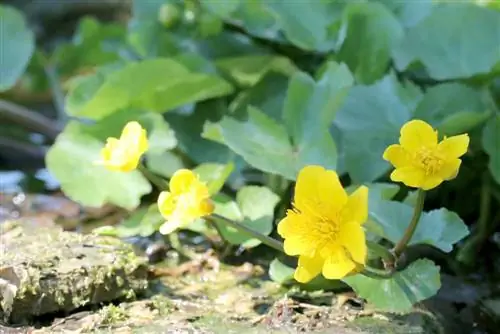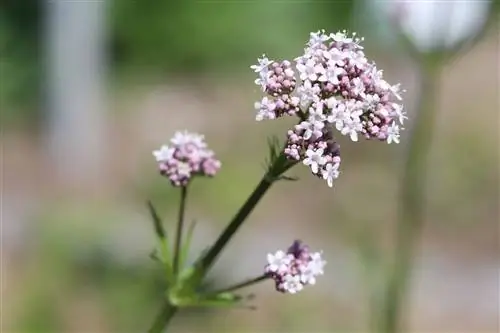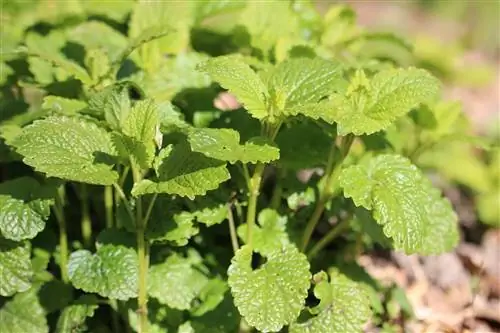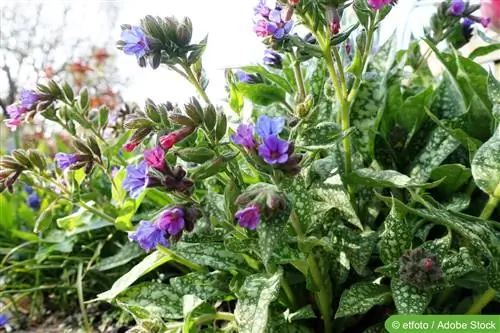- Author admin [email protected].
- Public 2023-12-17 03:39.
- Last modified 2025-01-24 12:45.
Decorative marigolds are an integral part of many local gardens. Because they fit in a tidy front garden as well as in a cottage garden with wild growth. Caring for Calendula officinalis is quite easy.
Profile
- lat. Name Calendula officinalis
- Daisy family Asteraceae
- not hardy and not perennial
- self-sowing
- grows up to 60 centimeters high
- bushy and herbaceous summer flowers
- yellow or orange flowers
- Flowering period from May to October
- non-toxic
- used as a medicinal plant
Location and soil conditions
Marigolds are sun-kissed as they are said to originally come from the Mediterranean region. Therefore, the location in the garden or on the balcony should be chosen accordingly:
- full sunny
- even midday sun in summer is tolerated
- brings intense and rich flowering
- loamy soil preferred
- more dry than moist
- Avoid nitrogen in the soil
- Plants then grow big
- but hardly or not at all blooming
Plants
When planting, please note that the marigolds can also be grown earlier in the year and then planted as finished small plants. This pre-breeding has the advantage of earlier flowering:
- Sow seeds from mid-March
- in potting soil in pots on windowsill
- sieve with sand and keep evenly moist
- Germination occurs after 15 days
- then put it a little cooler
- plant in the bed in May after the Ice Saints
- Keep a distance of 25 to 30 centimeters
- or simply place around or between vegetable plants
Tip:
A mixed culture with various vegetables is suitable as a plant neighbor, because the marigold, like its relative the marigold, keeps pests away from the vegetable plants.
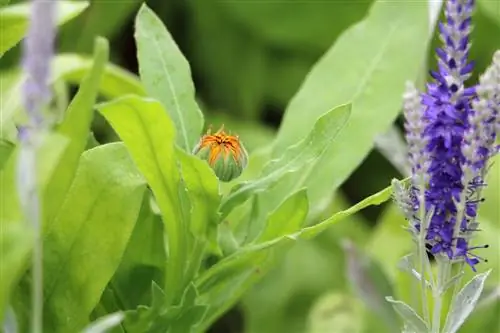
Sowing
Marigolds can only be propagated through seeds. These can be collected from existing dried flowers or purchased commercially. The easy-care marigolds germinate quickly and easily without having to pay much attention when sowing. The marigold can also be cultivated in a pot. This is particularly useful if there is no garden available and the boxes are to be planted on the balcony:
- Give seeds to the bed from April to June
- Loosen the soil beforehand
- Removing weeds
- Rake the seeds lightly afterwards
- cover about a centimeter with a layer of compost
- seedlings appear, remove excess plants
- Plant spacing about 25 to 30 centimeters
- Excess plants can be planted elsewhere
- normal potting soil is sufficient in the pot
- Create drainage via drain hole
A marigold needs space all around, this should also be taken into account when cultivating it in a pot, because too many plants in a pot will grow stunted or the plants will be attacked by fungi both in the pot and in the bed.
Tip:
If there are too many seedlings and you need to remove them from the bed, simply remove them from the soil with a spoon or hand shovel. This way the delicate roots are not injured.
Watering and fertilizing
The undemanding marigolds require little care. If the bed is prepared with sufficiently ripe compost before sowing or planting, then the nutrients it contains are usually sufficient for the entire growing year:
- no need to fertilize
- water only moderately
- promotes flower formation
- Avoid waterlogging at all costs
- Normally falling rain is usually enough
- only add water to the pot
- or in very long dry periods
Tip:
The addition “officinalis” in the Latin name comes from the word “officina,” which means “office.” However, this has been added to many medicinal plants since the 18th century in the sense of “pharmacy” or “laboratory”.
Flowering time
Calendula show beautiful and persistent flowers all summer long, from which the inconspicuous fruits later form:
- first flowers in May and June
- close overnight
- can only be achieved with pre-culture from March
- further flowers from July until well into October
- last flowers until first night frosts
- as soon as a flower fades, the next bud opens
- Achenes are formed from the flowers
- Closing fruits
- different curvature up to almost a ring
- hence the name marigold
Tip:
If you sow at different times, i.e. scatter new seeds in the bed until June, the flowers will be even more intense and last longer.
Diseases
Marigolds are unfortunately susceptible to various types of fungi such as loggerheads and powdery mildew. For this reason, the individual plants should not be cultivated too close together in the bed. From time to time, leaf spot disease can also occur if there is too much moisture:
- spray with diluted milk
- alternatively use diluted apple cider vinegar
- Plants are too close together
- thinning improves air circulation and drying
- Inject horsetail broth
- For prevention, fertilize with nettle manure
- Always ventilate well when covering in spring
If the plants were only attacked by the fungus in autumn, then no further measures need to be taken, as the annual marigolds die off with the first frost at the latest.
Tip:
If the marigolds in the garden bed have been affected by powdery mildew or leaf spot in one year, then you should not dispose of the plants in the compost, but rather tightly sealed in the residual waste.
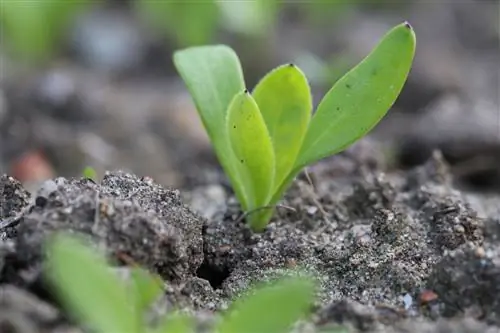
Pests
Unfortunately, many different pests are also known to affect marigolds. These include leaf bugs, leaf miners and aphids. This can be combated with insecticides. An alternative is a vinegar, dish soap and water mixture that is sprayed onto the plants. Further measures for pests are as follows:
- Rubbing pests with soft soap
- Make and spray nettle manure
- use natural enemies in the greenhouse
- this includes predatory bugs and parasitic wasps
- Make broth from garlic and water
- distribute essential oils
- from tree of life, peppermint, silver fir, sandalwood
- Use horsetail manure as a preventive measure
- Snails like to eat the leaves
- create snail barriers all around this
Tip:
A companion planting or mixed culture with chives, valerian, lavender, rosemary, anise, dill or fennel can also help to avoid pest infestation on the marigolds.
Cutting
Marigolds do not require pruning. Nevertheless, care should be taken so that the flower bed or balcony box always looks attractive:
- have a habit of leaves becoming dry
- has no meaning
- simply remove dry leaves
- Removing faded flowers
- only if it is not to be used for sowing
- Pull the plant out of the ground in autumn after the first frost
- dispose of completely
Note:
If the marigold dies after the first frost, the roots remaining in the ground will no longer sprout new plants, as is the case with perennials in spring.
Wintering
A marigold is not hardy and not perennial. The bed therefore does not need to be protected in winter. However, it sometimes seems as if the plants are hardy and perennial and this is for the following reason:
- in a mild region without late frosts
- Marigolds sow themselves
- leave the flowers on the plant until they dry out
- Seeds fall on the ground in autumn
- can spend the winter here
- In the spring germination occurs all by itself
- first tender plants appear from March
Note:
There is no other way to propagate the marigold than by sowing the collected seeds or self-sowing over the winter.


